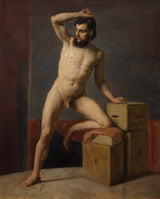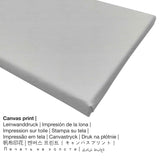Gustav Klimt, 1883 - Male nude - fine art print
Tax included. Shipping calculated at checkout.
What you should know the artpiece created by the Art Nouveau painter with the name Gustav Klimt
Male nude was by Gustav Klimt in 1883. The original version has the following size: 68 x 54,8 cm - frame dimensions: 72 × 59 × 3,5 cm. Oil on canvas was used by the Austrian artist as the medium of the masterpiece. Signed lower right: G. Klimt is the artwork's inscription. What is more, this artpiece belongs to the art collection of Belvedere. With courtesy of: © Belvedere, Vienna, inventory number: 5992 (public domain). : purchase from Theresia Reinhardt, Vienna in 1973. The alignment is in portrait format with a side ratio of 1 : 1.2, which means that the length is 20% shorter than the width. Gustav Klimt was a male painter, whose artistic style was mainly Art Nouveau. The artist lived for a total of 56 years - born in 1862 in Vienna state, Austria and passed away in 1918 in Vienna, Vienna state, Austria.
General information from Belvedere (© Copyright - Belvedere - www.belvedere.at)
This male nude study is one of the earliest paintings, which are known by Gustav Klimt. This is a typical example of the academic teaching. After Klimt of 1876 k at the up 1879th k. School of Applied Arts in Vienna had completed training as an art teacher, he was admitted on the recommendation of Rudolf Eitelberger of Edelsberg, director of the School of Applied Arts in Ferdinand race Bergers class for decorative painting. He was given access to higher education as a history painter, which could well compete with those at the prestigious Academy of Fine Arts. Running Bergers class was as Klimt's fellow student Franz Matsch wrote in his memoirs, organized against the prevailing academic conventions rather along the lines of an old master workshop, and after just over a year has been the "Artist Compagnie" which the brothers Klimt and Franz Matsch yet had formed at school, already with the execution of relevant projects of the master, as the graffito decoration entrusted in the courts of the Kunsthistorisches Museum and the Brno city Theater or the ceiling paintings at the Palais Sturany. In contrast to studies at the Academy of Fine Arts, the training was designed at the art school less on classical panel painting, but above all in providing equipment for prestigious buildings with decorative wall and ceiling paintings, in all styles of historicism. could carry out talented young artists, large orders quickly and conveniently, the ring road time was searched with the architects. A thorough study in figure drawing was for it as indispensable experience in portrait and Stillleben.Im context of studies at the School of Applied Arts was the subject Male Nude study. The exercise consisted in the detailed representation of the naked human figure, in particular, the anatomy of the muscular system should be studied in the respective posture of the model. Such studies were not intended to be sold on the art market. Unless they are destroyed, they remained mostly owned by the artist and often reached only through the estate to the public. This explains the total neglect of aesthetic appeal in this study explained. The model kneels on simple wooden boxes stacked in an unadorned studio space. Neither is kind of glossed over the crudely-looking bearded face, even the slightest effort is clearly to cover the pubic area from direct sight. In sharp contrast, however, is the pose of the model. With the defensiveness of the left hand reminds them figures of ancient battle sarcophagi. Klimt therefore studied here on naturalistic as possible, a classic picture formula. Not infrequently these nudes were out of the exercise in later episode as templates for (clothed) figures in historical paintings. [Markus Fellinger, 3/2012]
Piece of art details
| Artpiece title: | "Male nude" |
| Artwork classification: | painting |
| Category: | modern art |
| Temporal classification: | 19th century |
| Created in the year: | 1883 |
| Age of artwork: | over 130 years old |
| Artwork original medium: | oil on canvas |
| Size of the original artpiece: | 68 x 54,8 cm - frame dimensions: 72 × 59 × 3,5 cm |
| Signed (artwork): | signed lower right: G. Klimt |
| Museum: | Belvedere |
| Museum location: | Vienna, Austria |
| Website: | Belvedere |
| Artwork license type: | public domain |
| Courtesy of: | © Belvedere, Vienna, inventory number: 5992 |
| Creditline: | purchase from Theresia Reinhardt, Vienna in 1973 |
Artist information
| Name of the artist: | Gustav Klimt |
| Other names: | klimt gustav, gust. klimt, Gustav Klimt, g. klimt, Klimt Gustave, Klimt, Klimt Gustav, Gustave Klimt, クリムト, קלימט גוסטב, klimt g. |
| Gender: | male |
| Artist nationality: | Austrian |
| Jobs: | painter |
| Country: | Austria |
| Classification: | modern artist |
| Styles of the artist: | Art Nouveau |
| Died aged: | 56 years |
| Year of birth: | 1862 |
| City of birth: | Vienna state, Austria |
| Died: | 1918 |
| Died in (place): | Vienna, Vienna state, Austria |
Materials you can choose from
We offer a range of various sizes and materials for every product. You can choose your preferred material and size among the following options:
- Glossy acrylic glass print (with real glass coating): The print on acrylic glass, often denoted as a UV print on plexiglass, will transform the original artwork into home decoration. Above all, the acrylic art print forms a great alternative option to canvas or dibond fine art replicas. Your work of art is made with state-of-the-art UV direct print technology. The great upside of an acrylic glass print is that sharp contrasts plus smaller color details will be more exposed due to the subtle tonal gradation. Our acrylic glass protects your custom fine art print against sunlight and heat for between 4 and 6 decades.
- Aluminium dibond (metal print): An Aluminium Dibond print is a print material with an impressive depth effect. The bright & white sections of the artwork shimmer with a silk gloss but without glare. The colors of the print are bright and vivid in the highest definition, the details appear very clear. The print on Aluminum Dibond is the most popular entry-level product and is an extremely contemporary way to display artworks, because it puts the viewer’s attention on the whole artwork.
- The poster print (canvas material): Our poster is a UV printed canvas with a nice texture on the surface. Please keep in mind, that depending on the absolute size of the poster we add a white margin of something between 2-6cm round about the print, which facilitates the framing with your custom frame.
- The canvas print: The canvas print, not to be confused with a painting on a canvas, is a digital copy printed from an industrial printer. The great advantage of canvas prints is that they are relatively low in weight, meaning that it is quite simple to hang up the Canvas print without the help of extra wall-mounts. A canvas print is suitable for any type of wall.
The product specs
| Print categorization: | art reproduction |
| Method of reproduction: | digital reproduction |
| Manufacturing process: | UV direct printing (digital print) |
| Product Origin: | Germany |
| Type of stock: | production on demand |
| Intended product use: | gallery wall, wall décor |
| Alignment: | portrait alignment |
| Aspect ratio: | (length : width) 1 : 1.2 |
| Aspect ratio meaning: | the length is 20% shorter than the width |
| Available material variants: | acrylic glass print (with real glass coating), canvas print, poster print (canvas paper), metal print (aluminium dibond) |
| Canvas on stretcher frame (canvas print) size variants: | 50x60cm - 20x24", 100x120cm - 39x47", 150x180cm - 59x71" |
| Acrylic glass print (with real glass coating) variants: | 50x60cm - 20x24", 100x120cm - 39x47", 150x180cm - 59x71" |
| Poster print (canvas paper) size options: | 50x60cm - 20x24", 100x120cm - 39x47" |
| Aluminium print (aluminium dibond material) size variants: | 50x60cm - 20x24", 100x120cm - 39x47" |
| Frame: | not available |
Important information: We try everythig possible in order to depict the products as clearly as possible and to illustrate them visually. Nonetheless, the tone of the printing material and the printing can diverge marginally from the presentation on the monitor. Depending on the screen settings and the nature of the surface, not all color pigments will be printed as realistically as the digital version. In view of the fact that all are processed and printed manually, there might also be minor differences in the motif's exact position and the size.
Copyright © - Artprinta.com














